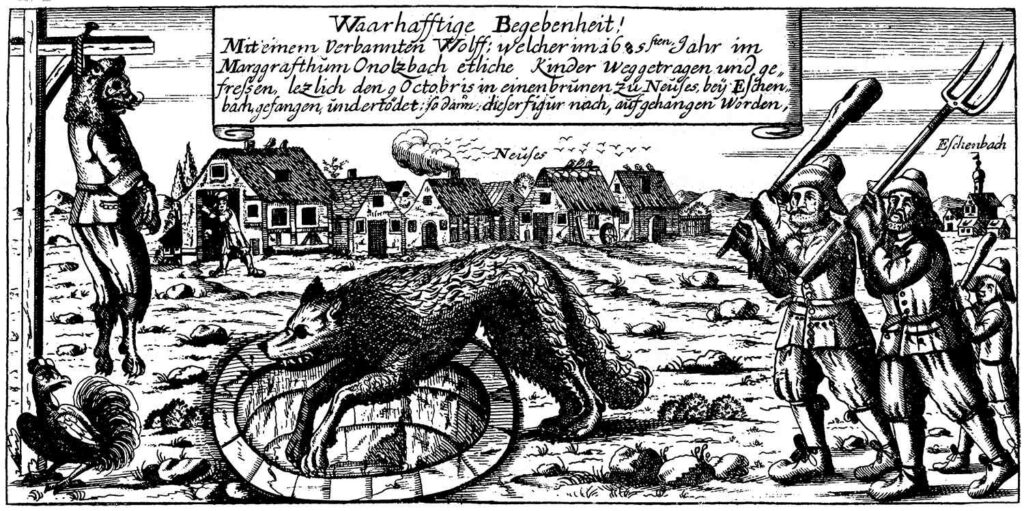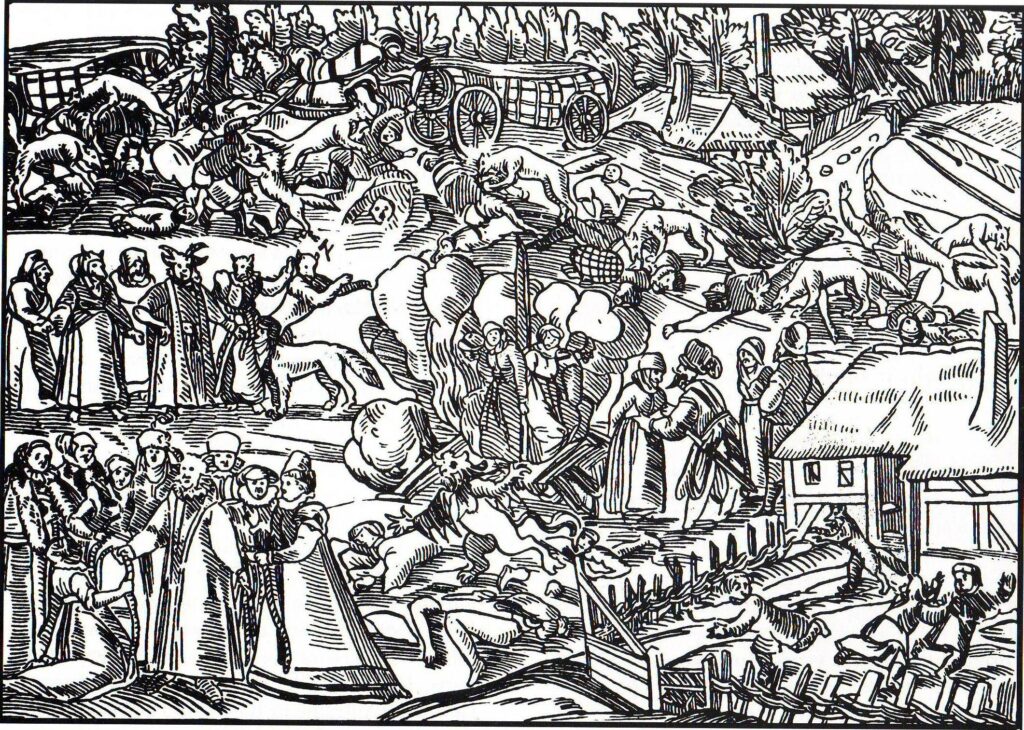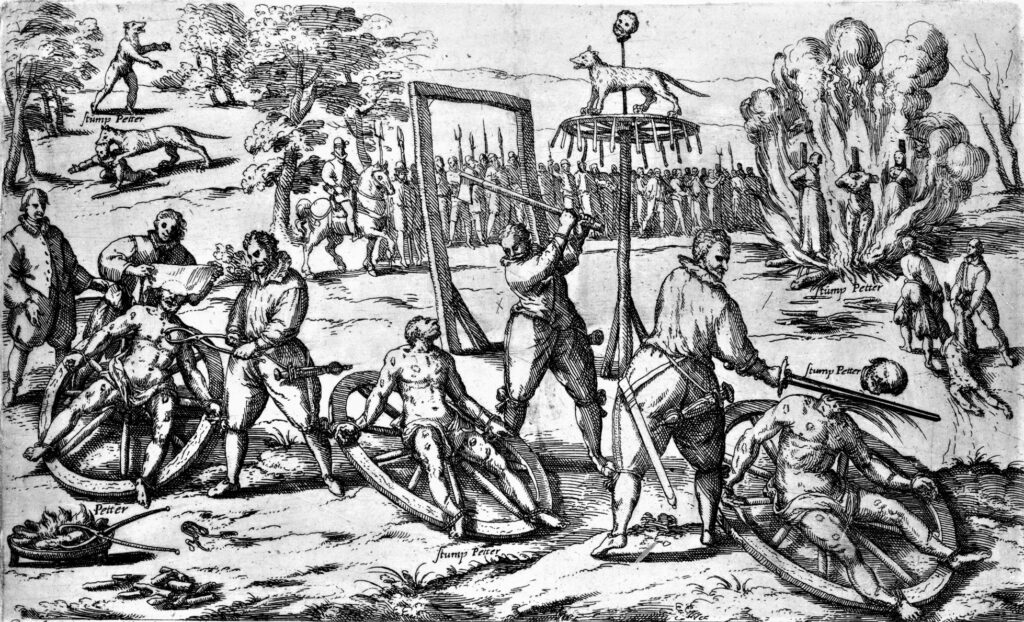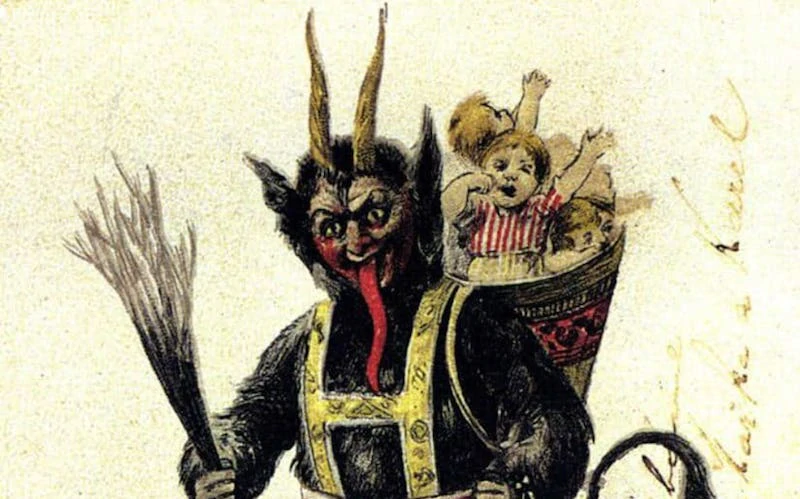In the dimly lit corners of French history, there lurks a chilling tale that has captivated imaginations for centuries. It is a saga of fear, superstition, and group hysteria.
Throughout the 16th and 17th centuries, the French Werewolf Panic swept across the land like a howling storm. It left terror, fear, and death in its wake.
For decades, hundreds of people reported sightings of werewolves. They claimed they saw men transform into ferocious beasts and attack innocent victims.
Described as a creature that is half-man, half-beast, werewolves figure prominently in myth and folklore going back many centuries. They are often associated with their beastly transformation, the power of the full moon, and a blood-thirsty, insatiable urge to kill.

These fears became so intense that the French government launched an investigation and trial of those accused. This led to brutal punishments, executions, and nationwide mass hysteria.
But what was really behind these claims? Of course, werewolves don’t exist.
So, how did the French Werewolf Panic grow? What drove people to believe in the existence of these fearsome creatures?
Europe’s Long History with Werewolves
Werewolf lore had a long and complex history throughout Europe. This stretched from the Middle Ages to the early modern period.
In early folklore examples, werewolves were typically portrayed as benign creatures. They were forced to shape-shift into beasts against their will. Purported sightings continually popped up across both rural and urban areas in Europe.
By the 1400s, charges of actual werewolfery emerged during the witch trials that swept through Europe. This occurred most often in Switzerland’s Valais region. There, hundreds of men and women were convicted and burned at the stake for allegedly adopting wolf forms and mutilating cattle.

The werewolf panic spread across the entire continent, any place where villagers and livestock were easy prey for actual wolves. Political and religious upheavals only heightened tensions.
Peasants blamed werewolves for more standard issues like dead livestock or interpersonal disputes. But the Church viewed them as pagan or Satanic.
The primary issue with these werewolf rumors quickly turned into accusations that they were in league with Satan. This became the more important issue, rather than the fact that violent attacks were happening to livestock.
As the werewolf/witch hunt intensified across Europe in the late 1500s and early 1600s, werewolves were often sentenced to death for witchcraft. This is opposed to their other supposed crime: that of being a werewolf.
Inquisitors were appointed by the Pope, who presided over several trials of alleged werewolfery. Confessions often only came after long bouts of torture. Many of the accused were mentally ill, or poor and estranged from the majority of the population.
France’s Werewolf Panic
The French Werewolf Panic was a fascinating, unique phenomenon that took the country by storm during the witch-hunts of early modern Europe. Particularly in the region of Burgundy.
Wolves were viewed as menacing creatures and represented sinister, dark threats.
This led to a remarkable number of people being accused of transforming themselves into werewolves. This often resulted in a series of trials that involved interrogation and torture to obtain evidence of guilt.
The ongoing mass hysteria around werewolves lasted from the early medieval period until the 18th century. It earned the historical title, “The French Werewolf Epidemic.”
According to some scholars, as many as 30,000 people were suspected of being werewolves in France between 1520 and 1630. However, the origin of this figure is mostly debunked.

Instead, the actual number of people executed after being accused of being a werewolf was likely much lower, in the hundreds. The accused were almost entirely men.
Where did this massive, deep-seated fear come from?
A deep fear of wolves in the European psyche dates back over a millennium. Some believe that the routine killing of wolves sanctioned by governments contributed to the panic.
Wolf killing became lawful under Charlemagne in the 800s. This may have furthered the belief that wolves represented sinister threats.
Werewolves were featured in medieval folklore for centuries. Yet, it wasn’t until around the 1400s that true panic ensued.
There were the trials of men such as Jacques Roulet or Gilles Garnier. They were accused of killing and torturing children. There were also the notorious tales of the Beast of Gévauda. A beast that reportedly terrorized the French countryside for decades.
Some individuals admitted to being werewolves. But they may have suffered from delusions or could not fully comprehend their confession. A small number may have been actual criminals, such as pedophiles or serial killers. But historical accounts are often incomplete and prone to exaggeration.
Altogether, the French Werewolf Panic was a significant, ongoing bout of mass hysteria. This led to the accusation and execution of many individuals for the crime of being a werewolf.
While the exact number of those who were executed is uncertain, the impact on the people of France and the broader European psyche still cannot be understated.
The Sagas of Pierre Burgot, Michel Verdun, and Jacques Roulet
The French Werewolf Panic of the 1500s and 1600s was a time of widespread fear and paranoia about the existence of werewolves. As a result, many men were caught facing the consequences.
Some of the most famous stories of individuals caught up in this hysteria who were accused of being werewolves were the stories of Pierre Burgot, Michel Verdun, and Jacques Roulet.
Michel Verdun was the first to be accused in 1521. What happened was, a traveler was attacked by a wolf. This man followed the animal’s trail, and at its end was a wounded and bloody Michel Verdun.
Verdun not only confessed during his trial to being a werewolf but also named Pierre Burgot and Philibert Montot as fellow wolves.
Their stories were inconsistent, however. Verdun said that he was given the power by an unknown man. Burgot said that Verdun gave him an ointment and forced him to renounce his baptism.
Montot refused to confess to being a werewolf. But he was still found guilty and was burned at the stake.
The three men were some of the first victims of the panic. No historian has yet to come up with an adequate explanation for why both Verdun and Burgot freely admitted to being werewolves.
Another famous werewolf account was that of a man named Jacques Roulet.
Roulet was accused of being a werewolf in the 1590s. He was caught with his clothing in tatters, his hands drenched in blood, and with shreds of human flesh under his fingernails. He was found after two hunters came across two wolves feeding on the body of a dead 15-year-old boy.
During his questioning, Roulet claimed that he had been a werewolf ever since using a salve that his parents gave him years before.
Roulet stated that his brother, Jean, and his cousin, Julien, were also werewolves. He said that the three of them would go out hunting women and children together.
Like Verdun, Burgot, and Montot, Jacques Roulet was charged with murder and accused of being a werewolf. All of their accounts were received as the truth in a time of widespread fear and paranoia about the supernatural.
While it’s difficult to separate fact from fiction in these stories, they provide a glimpse into the French Werewolf Panic and the way that fear and hysteria can sweep through a population.
The Case of Gilles Garnier
The story of Gilles Garnier is another example of the werewolf panic in France in the 16th century.
In 1572, a group of people in Dole, France discovered the half-eaten remains of multiple missing children in the nearby woods. They quickly began their search for the culprit. They believed it was Gilles Garnier, a poor immigrant who lived in the woods nearby.
Garnier, known to be an odd figure, was quickly accused, along with his wife. Over 50 witnesses testified against them.
After being subjected to torture on the rack, Garnier eventually confessed to being a werewolf and killing and eating the children.
The hermit testified that a ghost appeared to him and gave him an ointment that would allow him to shape-shift. He confessed to stalking, killing, and even cannibalizing multiple children throughout the autumn of 1572.
Less than a year later, he and his wife were burned at the stake.
To this day, it remains unclear whether Garnier actually believed himself to be a werewolf or if he was simply coerced into confessing under torture.
France’s Most Notorious Monster: The Beast of Gévaudan
Many of the werewolf panic cases were ultimately proven to be the work of human killers or other animals. But the Beast of Gévaudan, also known as La Bête du Gévaudan, is one of the most infamous and mysterious cases of wolf terror in history.
The Beast of Gévaudan was a man-eating animal (or animals) that terrorized the province of Gévaudan in France in the 1700s. According to eyewitnesses, the attacks were committed by one or more beasts with formidable teeth and immense tails.
For three years beginning in 1764, the beast supposedly killed and partially ate over 100 people, almost exclusively women, and children. However, the number of victims differs according to the source. Some estimate there were 210 attacks. Other sources claim between 60 and 100 adults and children were killed.
Descriptions of the beast also vary. Reports may have been greatly exaggerated owing to public hysteria.
Its appearance was generally described as a wolf-like canine with a tall, lean frame. Possibly the size of a cow, or, in some cases, a horse. The beast’s fur was described as tawny or russet, but its back was streaked black.
Some speculated that it was a werewolf. Others believed it was a hyena or a large dog. Whatever it was, it was terrifying and deadly.
Locals reportedly hunted down and killed the beast several times. Yet it was years before the attacks stopped.
The attacks were so shocking and terrifying that news of them traveled from the countryside to the royal palace in Versailles. King Louis XV even offered a bounty for the beast’s head.
The legacy of the Beast of Gévaudan lasted long beyond the 18th century. It remains a topic of fascination and speculation to this day. The beast’s identity and origins remain a mystery.
According to modern scholars, public hysteria at the time of the attacks contributed to widespread myths of supernatural beasts roaming Gévaudan. But deaths attributed to the beast were more likely the work of several wolves or packs of wolves.
The legend of the Beast of Gévaudan remains unsolved, as do the many hundreds of werewolves accused and burned at the stake, throughout the panic.
What Caused the Werewolf Panic in France?
One possible explanation is that people were using hallucinogenic salves which contained ingredients like belladonna or nightshade. This would have heavily influenced their minds and caused them to feel like they had fur.
Ergot-contaminated bread is another theory. Ergot contains chemicals similar to LSD, which may have induced powerful hallucinations in those who mistakenly ate it.
The potential for mind-altering substances being the primary cause would explain the many men who freely admitted to being werewolves. It also helps explain the common theme of mysterious ointments and salves.
Yet another cause could have been rabies. At this time, rabies was still often being passed between wolves and humans and could have been behind the strange and violent actions of victims.
Attacks by wolves were a very serious problem during the era. This wasn’t only a problem in France but throughout Europe. Thousands of deaths were attributed to wolves in the 18th century. It’s possible that this pattern of wolf attacks played a large role in the hysteria.
Human violence and reactionary behavior were key in the spread of the werewolf panic. Mass hysteria typically underpins any such outbreak of wild, unbelievable tales of witchcraft and the like.
The French Werewolf Panic remains a mysterious and intriguing chapter in history, offering a reminder of the power of belief and the human capacity for fear and hysteria.
References
Beck, Melinda. “Before America Had Witch Trials, Europe Had Werewolf Trials.” History.com. A&E Television Networks, October 15, 2021. https://www.history.com/news/werewolf-trials-europe-witches.
Flint, Wynne. “Werewolf Trials: Witch Trials with a Hairy Twist.” History Daily, October 11, 2019. https://historydaily.org/werewolf-trials/7.
Jones, Josh. “Revisiting the French Werewolf Epidemic and the Beast of Gévaudan.” Flashbak, September 15, 2020. https://flashbak.com/revisiting-the-french-werewolf-epidemic-and-the-beast-of-gevaudan-432426/.
Schulte, Rolf. “‘She Transformed into a Werewolf, Devouring and Killing Two Children.’” She-wolf, May 2015, 41–58. https://doi.org/10.7765/9780719098192.00006.

